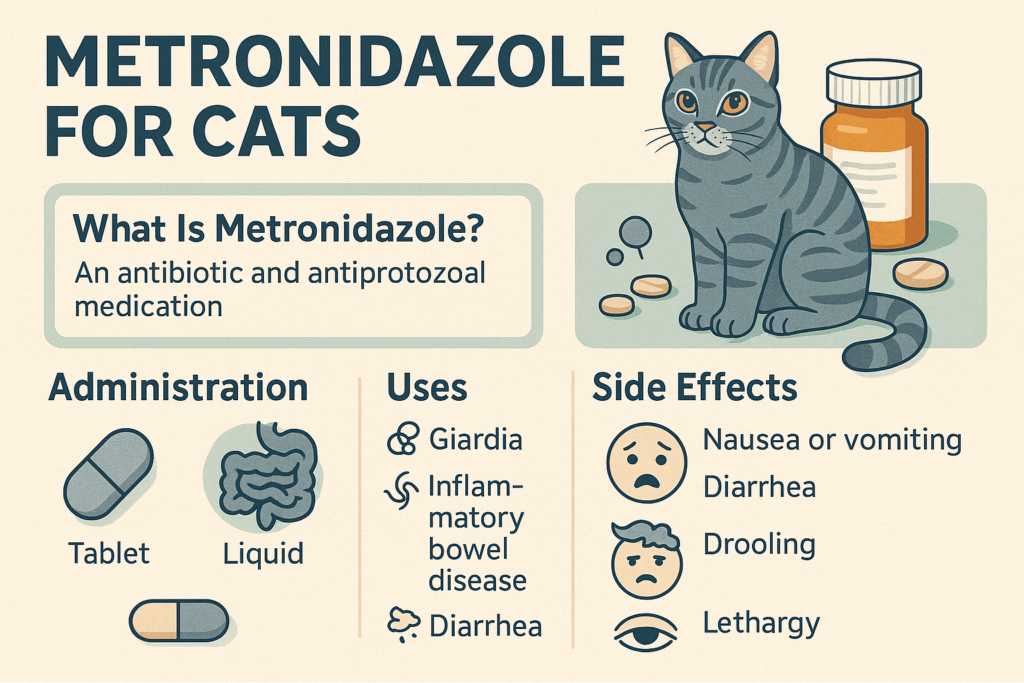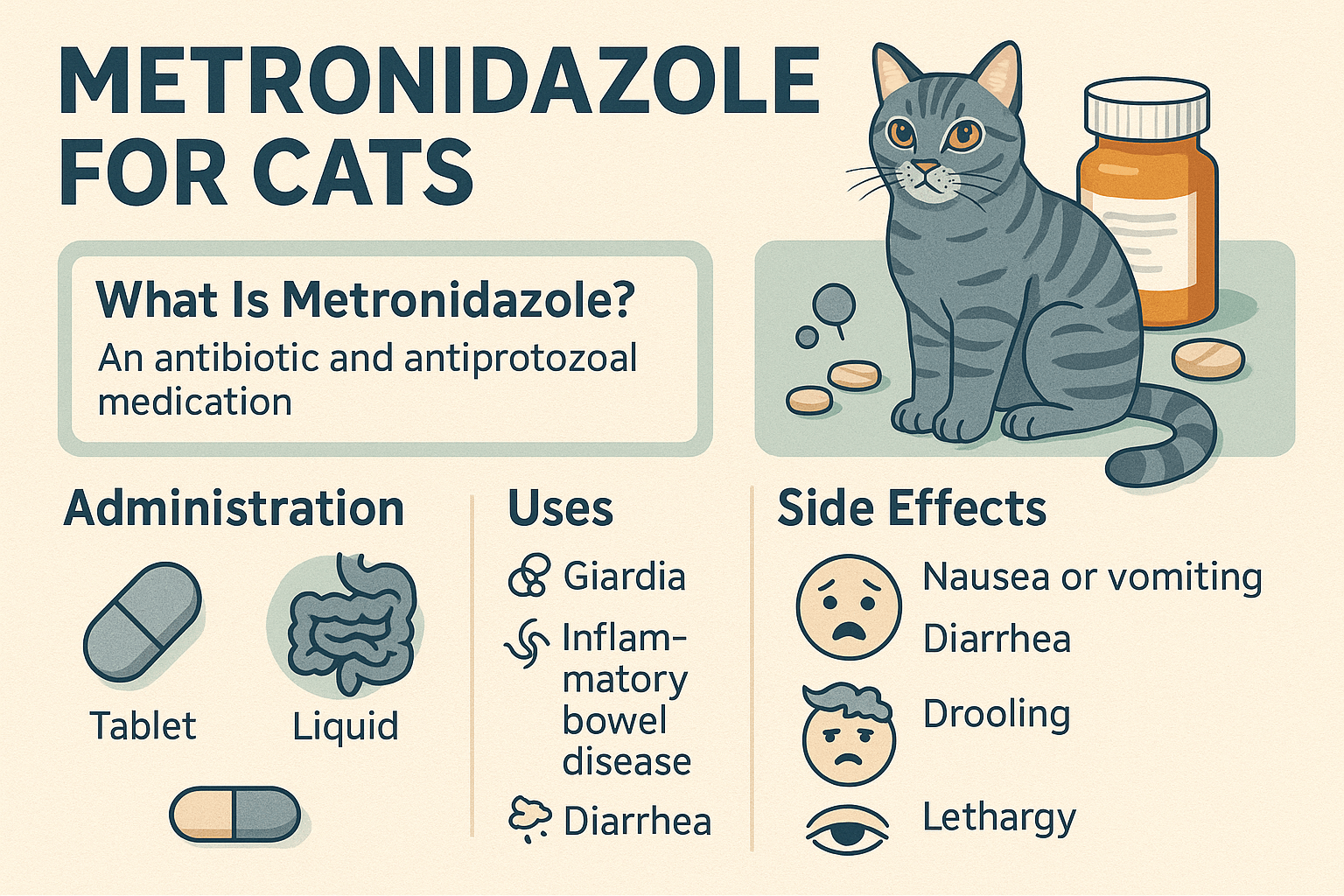Metronidazole for Cats: What You Need to Know
When it comes to treating certain health conditions in cats, veterinarians often turn to medications like metronidazole. This versatile drug is commonly prescribed for a variety of ailments, from gastrointestinal issues to infections. But what exactly is metronidazole, and how does it benefit our feline friends? Understanding its uses, dosage guidelines, and potential side effects is crucial for ensuring your cat’s safety and well-being. In this blog post, we’ll explore everything you need to know about metronidazole for cats, helping you make informed decisions about their healthcare.
Expert Insight: How Metronidazole is Administered
“Metronidazole is most frequently given as an oral medication and is also available as an injection administered in the hospital by a veterinarian. Your veterinarian will determine which combination is best for your pet, based on their circumstances and symptoms.”
Common Uses of Metronidazole in Cats
Metronidazole is a widely used antibiotic and antiprotozoal medication that addresses a range of health concerns in cats. Here are some of the most common reasons veterinarians prescribe this medication.
Treatment of Giardia Infections:
Giardia, a parasitic infection, can cause diarrhea and dehydration in cats. Metronidazole effectively targets the protozoa responsible for this condition.Management of Inflammatory Bowel Disease (IBD):
Metronidazole’s anti-inflammatory properties help reduce symptoms associated with IBD, such as vomiting and chronic diarrhea.Combatting Bacterial Infections:
The drug is effective against anaerobic bacteria, which thrive in low-oxygen environments and can lead to serious infections.Addressing Dental Issues:
Metronidazole may be prescribed to treat periodontal infections or abscesses caused by oral bacteria.Preventing Post-Surgical Infections:
Veterinarians sometimes use metronidazole prophylactically after surgeries to prevent infections in surgical sites.
With its broad range of applications, metronidazole plays a vital role in maintaining feline health, but it should always be administered under veterinary supervision.

How to Administer Metronidazole Safely
Giving medication to a cat can be challenging, but proper administration ensures the treatment works effectively without causing stress to your pet. Follow these tips for safe and successful dosing.
Follow Your Vet’s Dosage Instructions:
The dosage of metronidazole depends on your cat’s weight, condition, and severity of symptoms. Never adjust the dose without consulting your vet.Choose the Right Form:
Metronidazole is available in tablets, capsules, and liquid formulations. Ask your vet which form is best suited for your cat’s needs.Hide Pills in Treats or Food:
If your cat resists taking pills, try hiding them in soft treats, pill pockets, or a small amount of wet food.Use a Pill Dispenser:
A pill dispenser or “pill gun” can help you place the medication directly at the back of your cat’s throat, ensuring they swallow it.Monitor for Side Effects:
Keep an eye on your cat’s behavior and physical condition during treatment. Report any unusual symptoms to your veterinarian immediately.
By following these guidelines, you can ensure your cat receives the full benefits of metronidazole while minimizing risks.
Check this guide 👉Penicillin for Cats: Best 7 Health Tips!
Check this guide 👉Probiotics for Cats: Best 7 Expert Tips!
Check this guide 👉Mirtazapine for Cats: Best 7 Expert Tips!
Benefits of Metronidazole for Cats | Potential Side Effects to Watch For |
|---|---|
Effective against giardia infections | Loss of appetite |
Reduces inflammation in IBD | Vomiting or nausea |
Treats anaerobic bacterial infections | Diarrhea or upset stomach |
Helps manage dental infections | Neurological symptoms (rare) |
Prevents post-surgical complications | Allergic reactions (very rare) |
Signs That Your Cat May Need Metronidazole
If your cat is exhibiting specific symptoms, your veterinarian might recommend metronidazole as part of their treatment plan. Recognizing these signs early can lead to faster recovery.
Persistent Diarrhea:
Watery or bloody stools lasting more than a day could indicate an infection or gastrointestinal issue treatable with metronidazole.Vomiting or Nausea:
Frequent vomiting or retching may signal an underlying problem requiring medical intervention.Bad Breath or Oral Pain:
Foul-smelling breath or difficulty eating could point to a dental infection that metronidazole can help address.Lethargy or Weight Loss:
Unexplained fatigue or sudden weight loss often accompanies chronic conditions like IBD, where metronidazole may be beneficial.Post-Surgical Symptoms:
Swelling, redness, or discharge near a surgical site may require preventive or corrective treatment with antibiotics like metronidazole.
Understanding these indicators helps you recognize when professional care—and potentially metronidazole—might be necessary.
Tips for Managing Side Effects of Metronidazole
While metronidazole is generally safe, some cats may experience side effects. These tips can help you manage or mitigate any adverse reactions during treatment.
Offer Smaller, Frequent Meals:
If your cat loses their appetite, provide smaller portions throughout the day to encourage eating.Stay Hydrated:
Ensure your cat has access to fresh water to prevent dehydration, especially if they’re experiencing diarrhea or vomiting.Monitor Neurological Symptoms:
Rare cases of neurological side effects, such as stumbling or seizures, require immediate veterinary attention.Provide Comfort and Rest:
Create a quiet, cozy space for your cat to rest and recover during treatment.Communicate with Your Vet:
Regular updates to your veterinarian allow them to adjust the dosage or switch medications if needed.
By staying vigilant and proactive, you can minimize discomfort and ensure your cat recovers smoothly.
Precautions When Using Metronidazole
Before starting metronidazole treatment, it’s essential to understand precautions to ensure your cat’s safety. Taking these steps minimizes risks and promotes successful outcomes.
Inform Your Vet of Other Medications:
Certain drugs can interact with metronidazole, so disclose all medications or supplements your cat is currently taking.Avoid Long-Term Use Without Supervision:
Prolonged use of metronidazole can lead to resistance or toxicity; regular check-ups are necessary for extended treatments.Watch for Allergic Reactions:
Signs like swelling, itching, or difficulty breathing indicate an allergic reaction requiring immediate veterinary care.Do Not Crush Tablets Unless Directed:
Crushing tablets may alter the drug’s efficacy or irritate your cat’s mouth; follow preparation instructions carefully.Store Medication Properly:
Keep metronidazole in a cool, dry place out of reach of children and pets to prevent accidental ingestion.
Taking these precautions ensures your cat’s treatment remains safe and effective.
Alternatives to Oral Metronidazole
If your cat struggles with oral medications, alternative delivery methods or treatments may be available. These options provide flexibility based on your cat’s preferences and needs.
Injectable Formulations:
Injectable metronidazole is an option for cats who resist oral medications, though it must be administered by a professional.Compounded Flavored Suspensions:
Compounding pharmacies can create flavored liquids that make the medication more palatable for picky eaters.Probiotics for Gut Health:
In mild cases of IBD or diarrhea, probiotics may complement or even replace metronidazole under veterinary guidance.Dietary Adjustments:
Switching to hypoallergenic or easily digestible diets can alleviate symptoms without relying solely on medication.Natural Supplements:
Some herbal remedies, like slippery elm or marshmallow root, may support gut health, though they should never replace prescribed treatments.
Exploring alternatives ensures your cat receives the care they need in a way that suits their personality and condition.
Building Trust During Medication Time
Administering medication can strain the bond between you and your cat, but building trust makes the process smoother and less stressful. Use these strategies to foster cooperation and confidence.
Associate Medication with Positive Experiences:
Reward your cat with treats, praise, or playtime immediately after giving medication to create positive associations.Use Calming Techniques:
Speak softly, stroke your cat gently, and maintain a calm demeanor to reduce anxiety during medication time.Practice Handling Paws and Mouth:
Regularly touching your cat’s paws and mouth outside of medication times helps them become accustomed to handling.Respect Their Boundaries:
Allow your cat to retreat and regroup if they seem overwhelmed, then try again later with patience.Celebrate Small Wins:
Acknowledge progress, even if it’s incremental, to stay motivated and reinforce positive behaviors.
By prioritizing trust and patience, you can transform medication time into a bonding experience for both you and your cat.
Frequently Asked Questions About Metronidazole for Cats
What is metronidazole used for in cats?
Metronidazole treats bacterial infections, giardia, inflammatory bowel disease, and dental issues in cats.
Can I give my cat metronidazole without a prescription?
No, metronidazole should only be administered under veterinary guidance to ensure proper dosage and safety.
How long does it take for metronidazole to work?
Improvement typically occurs within a few days, but the full course of treatment must be completed for optimal results.
Are there alternatives to metronidazole?
Depending on the condition, other antibiotics or treatments may be available; consult your vet for options.
What should I do if my cat misses a dose?
Administer the missed dose as soon as possible, unless it’s close to the next scheduled dose. Never double up on doses.
Ensuring Safe and Effective Use of Metronidazole for Your Cat
Metronidazole is a powerful tool in veterinary medicine, offering relief for a variety of feline health issues. However, its effectiveness depends on proper administration and careful monitoring. By working closely with your veterinarian, recognizing signs of illness, and managing side effects, you can ensure your cat receives the best possible care. Remember, your cat’s health is a shared responsibility, and being informed empowers you to make the best decisions for their well-being. With the right approach, metronidazole can help your furry friend feel better and return to their playful, happy self in no time.
Can a Cat Die from a Cold? Best 7 Expert Tips! Learn how to identify, treat, and prevent feline colds while understanding when to seek veterinary care for your cat’s health.
Cat Screaming for Food: Best 7 Expert Tips! Discover effective strategies to manage your cat's food-related vocalizations and create a peaceful feeding routine.
Aspiration Pneumonia in Cats: Best 7 Expert Tips! Discover causes, symptoms, and treatment advice to protect your cat’s respiratory health and ensure a speedy recovery.
Hip Dysplasia in Cats: Best 7 Expert Tips! Discover expert advice on managing hip dysplasia in cats, from symptoms and prevention to treatment options for a happier, healthier feline life.





